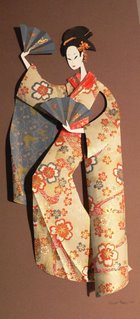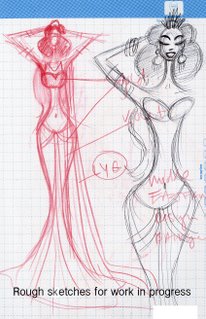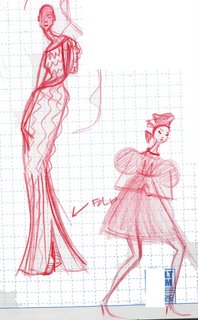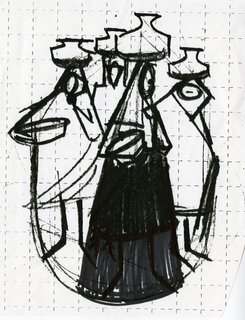MEGAN BRAIN INTERVIEW
Paper Sculpture
Sunday, December 03, 2006
BROUGHT TO YOU BY THE CHARACTER DESIGN BLOGSPOT
THE INTERVIEW

Tell me a little bit about yourself, about your life? Where did you go to school, and what classes did you study? What helped prepare you to become the artist that you are today?
I grew up in southern
How do you go about designing, and what goes through your mind, from start
to end?
I start a project by asking myself a series of questions. What can be exaggerated , what is the focus, am I going to make the piece seem symmetrical or asymmetrical, do I want it to have a lot of curved shapes or rigid angular shapes. When you get to the color stage, you have to ask yourself a whole new set of questions. Once I have started cutting and putting shapes down, I can see what I am working with. Typically, at this stage, I end up having more ideas for the piece and explore my options before gluing it all down . The real perk to paper sculpture is how flexible it is. It is so easy to add and subtract from the piece and assess what is in front of you. I can build a paper sculpture up to see if I can make it bigger than life, or take pieces away to simplify the design for a more contemporary and sophisticated look. One of my goals is to have a diverse body of work. I make a conscious effort to explore various color schemes and subject matters.
What is a typical day for you, and who are the people you work with?
I do all my art after work and on the weekend at home. My dad and my fiancé are both artist so I like to run my stuff past them for feedback.
What are some of the things that you have worked on?
I recently created some pieces for the next Henry Selick stop motion film “Coraline” slated to be released in 2008 by Laika Entertainment in
Is there a design you have done that you are most proud of?
I’m proud of my little white Hong Kong Junk boat because it was my first attempt at paper sculpture. Figuring out how to construct it kick started my mind into thinking in a whole new way. It was wonderful to find a medium that really intrigued me and helped me become inspired about creating artwork again. I say “again” because I was artistically dead for a few years after art school.
Who do you think are the top artists out there?
Tadahiro Uesugi is a Japanese illustrator and is the most exciting artist when it comes to composition and design. Eduard Erlikh is an amazing fashion illustrator, and this French artist at Dreamworks named Nicolas Marlet is out of this world when it comes to character design. Charles Harper is wonderful for his incredibly strong graphic work. There are too many great artists to list. All the people linked on my blog I really admire and check in on regularly. Some other favorite artists (that don’t have blogs) are Mucci Fassett, Craig Kellman, Jenny Gase-Baker, Lynne Naylor, Chris Reccardi, Peter Sohn.
Could you talk about your process with your paper designs, as well as the types of tools or media that you use?
I usually start out with a lose drawing after I get inspired by an idea or a picture. My drawings function more as loose notes for a project rather then an exact map of what it will be. I usually cut out a few shapes for the sculptures and play with ideas for the composition and the background. I primarily use bristol board witch is light but still pliable and sturdy. It can also withstand the Cartoon Color acrylic paint that I like to use. For the most part I tend to cut out shapes without having a line to follow-- when I try to follow a drawn line, It can come out pretty stiff and rigid. When the cut out shape or design doesn’t come out strong, I’ll do it again and again until it works.
Drawing with the knife is a lot like drawing with a bold marker. There is a confidence and strength that comes through when it is approached without fear, tension, or apprehension. My early figure drawings where crap because I was stressing too much importance on an outline of a figure rather then identifying the bold shapes. I would make these little light rigid stokes with a pencil that just made everything look hairy and choppy. I wasn’t looking for the bigger picture. Some people skip that stage, but I needed that type of thinking repeatedly knocked into my head by instructors.
What part of designing is most fun and easy, and what is most hard?
The best part is being excited about the potential for a piece. Getting that potential out and made into a physical object is hard. Oh... and forking over tons of money on supplies and box frames is also difficult.
What are some of the things that you do to keep yourself creative?
I find inspiring reference books of animals, cultures, places, and art. Google imaging is a GOD SEND! I love films and sometimes the imagery in them will give me ideas for projects or themes.
What are some of your favorite designs which you have seen?
I love the fashion illustrations or René Gruau and Erte.
What is your most favorite subject? And why?
Cultural themes are the most exciting to me. I’m in awe of world cultures and colors. I also love costuming, fashion and the animal kingdom.
What inspired you to become an Artist?
I think it is something I had to mature into. Growing up I loved doing art projects, seeing movies, and performing. When I would do a play I hated how I had to rely on other people’s feed back about my performance to know how I did. Whether they thought it was good or bad, a part of me wanted to be the judge of that. It tortured me to have to watch my taped performances in drama class. I found myself getting caught up in stupid things like how my butt appeared in some pants rather then how my acting performance came across. No matter how hard I tried I could not be objective. The visual arts allows you to step back and look at something you have made; it is easier to separate yourself from it. It’s also nice to physically make something and have it represent you. Animation appealed to me because you don’t fall victim to typecasting. You can be any age, any animal, and either gender.
What are some of the neat things you have learned from other artists that you have worked with or seen?
I learned how beautiful a loose drawing can be from Corny Cole, and how to break down the human figure into shapes from Glen Vilpu. My dad showed me how to look for the pure structure in a form, and is always helpful in pointing out a potential weakness in a design that I might have overlooked. Leo Monahan not only showed me paper sculpture techniques, but has an amazing knowledge for color and design. He was hands down the best teacher I’ve ever had. His Design and Color course is based off of the findings of German Bauhaus artist and teacher Johannes Itten. His books are a little dry but the knowledge contained in it is concise and invaluable. Leo did an amazing job explaining the theories of design and color based off Ittens studies. His classes are rich in knowledge and he is very entertaining; he loved spicing up the lessons with off color jokes and wild stories.
What are some of your favorite web sites that you go to?
Most of them are linked on my web site and/ or blog.
What wisdom could you give us, about being an Artist? Do you have any tips you could give?
If you haven’t found what art form you like, keep exploring. I thought animation was for me, but I eventually realized my heart wasn’t in it. Consider yourself blessed if you find what you love to do early in your life or college education. I have met a few people in the industry that start off in one job but discover they were cut out for a different position. I think there are Animation programs out there that should offer a much broader animation curriculum. Students should have the opportunity to explore all the aspects of Animation production. Currently it seems like all the educational resources go towards animation, character design and modeling classes. There are so many more aspects of animation to specialize in such as background design, background color, prop design, cleanup, effects animation... just to name a few.
If people would like to contact you, how would you like to be contacted?
My web e-mail is the best way to get me... papersculpt@yahoo.com.
You can also leave a comment on my blog: meganbrain.blogspot.com
Finally, do you have any of your art work for sale (sketchbook, prints, or anything) for people that like your work can know where and when to buy it?
I have a few sculptures for sale and will be adding that information onto my web site in the near future. I will also sometimes consider personal commissions depending on the subject matter and if I’m not too busy with other things.











